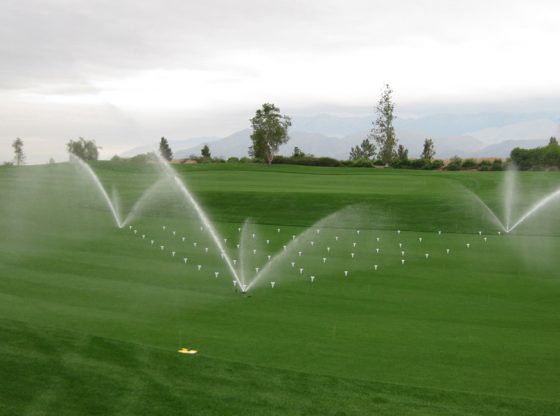What is the most difficult maintenance struggle you face on the course? If your answer was slopes, you are among the majority. No matter what maintenance you are preforming, it is more difficult on a slope. Unfortunately, slopes are unavoidable due to the aesthetic appeal as well as for functional reasons. Learning how to cope with slopes successfully will help you get the most out of them without undue struggle.
Slope Problems
Each slope is different. Gentle slopes are desirable because a 2 to 3 percent drop-off facilitates water movement away from buildings, yet still generally allows for adequate water movement down through the soil profile. However, when a slope is 4 percent or greater, problems may arise. Four main problems associated with slopes are: low infiltration, difficult mowing, poor fertilizer uniformity, and mulching difficulty.
Low Infiltration
On flat or relatively flat ground, water has a longer time to soak in before runoff occurs. As the slope increases, runoff occurs more quickly and infiltration therefore decreases. As a result, plants at the top of the slope don’t get enough water and plants at the bottom of the slope get too much. Both results create an unhealthy growing situation for plants. The soil will be drought-prone at the top of the slope, while soggy soil at the bottom. This may create conditions that cause root rots.
Difficult Mowing
Slopes are difficult to mow safely. When mowing a slope, the weight of the mower is not evenly distributed, leading to two problems. First, the increased risk of overturning of the mower. Second, the difficulty in steering, because more weight is being applied to down-slope wheel. The steering problem creates excessively worn turf as the wheel crushes turf plants during turning and slipping.
Poor Fertilizer Uniformity
Related somewhat to the problem of uneven water infiltration, fertilizer application and uptake is also problematic on slopes. Rainfall can cause the particles to wash down the slope, which can also occur with herbicides. When chemicals are applied unevenly, the concentration at the top of the slope can get to a point where it is no longer effective. On the other side, if enough chemical washes to the bottom of the slope, it could cause phytotoxicity.
Mulching Difficulty
The fourth category of trouble with slopes is retaining mulch. Just as fertilizer, herbicides and water are prone to tumbling down the slope, mulch also has a hard time staying put.
Using plant by-products such as bark nuggets, cypress pieces, stump grindings, cocoa bean hulls, cottonseed hulls, and wood chips as mulch has proven more effective. Organic mulches are relatively short-lived, but have a better capacity to cool the soil and retain moisture than inorganics. In addition, they look more natural as well. However, with use on sloped, the weight and characteristics of rock, stone and rubber allows for less shift in the mulch.
Slope Solutions
If you weren’t convinced before that slopes were a problem, you should be now. A well designed and maintained slope can be a wonderful accent or backdrop, as well as functional.
The first step in finding a solution to slope issues is to decide whether to keep growing turf or change the plant material. A new plant design may be a better and easier solution.
Replacing Turf
The simplest design solution is to replace the existing turf on the slope with groundcovers, ornamental grasses or some other low maintenance material. Hundreds of choices make viable turf replacements, but consider your locale in the choice. Taking out turf also means you have less to mow, which eliminates the safety hazard.
Alternative plantings may be a long-term solution, but establishing them can still be problematic. One strategy is to kill the existing turf, but leave it in place. Then you can cut holes in the sod for installing the new plants, and lay mulch of the dead turf.
Keeping Turf
If you choose to keep the turfgrass, there are three design solutions that are involved. First, in some cases you are dealing with a steep slope that is surrounded on all sides by large areas of flat ground. Regrading the site will spread the slope out over a larger area. This reduces the steepness and makes it easier to maintain. Sometimes simply moving the soil around and re-grassing the area will suffice.
Second, is dealing with terracing or installing retaining walls. You do not have adequate room to spread out the steep hill to a more gradual slope in all cases. This is where installation of a terrace or retaining wall comes in. Although neccissary, this step may require a landscaping architect.
Third, is simply changing management. In addition to physical changes, consider changing your management strategy.
Sustainability of Sloped Turf
There are four maintenance techniques that will greatly improve the sustainability of a sloped landscape.
1. Aeration and Topdressing Any technique that improves infiltration will reduce runoff. The common maintenance practice of aeration will increase the percolation rate, enhancing downward water movement. After aeration, consider topdressing with compost or processed clay.
2. Application of Plant Growth Regulators
Plant growth regulators slow the growth of the turf. This results in fewer mowing operations. Identify the times of the year when the turf is growing most, then focus suppression efforts accordingly. Spring and fall are likely targets for cool-season turfgrasses, while late spring and early summer are appropriate times for warm-season grasses.
3. Switching to No-Mow Grasses
Buffalograss naturally grows at a very slow rate. In addition to slow growth, buffalograss stays short. Unmowed buffalograss may not even reach 8 to 9 inches. This works well on a slope. There are also other turf species that work this way
4. Watering Top of Slope Only
Watering uniformity is important. So, on a slope watering the top and not the bottom or the middle makes since. Depending on the degree of slope, water applied to the top will flow downhill, soaking in along the way.
As a grounds manager, you have a choice when dealing with slopes. You can continue to battle them, or choose to implement changes that will help turn a problem into a thriving area.












